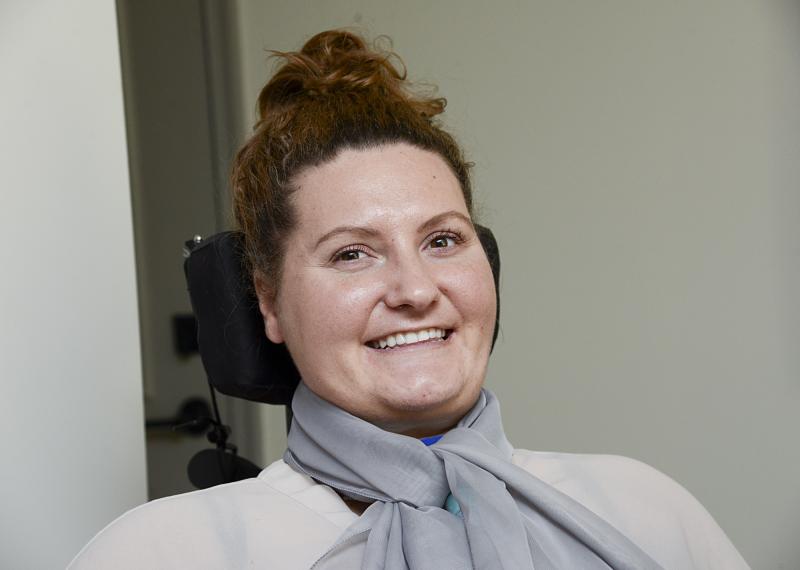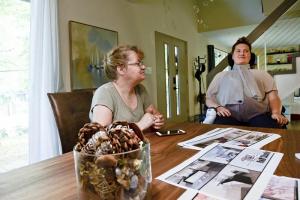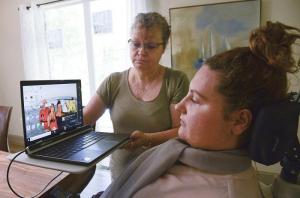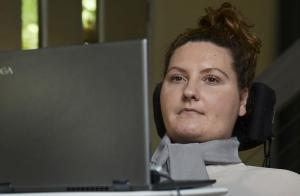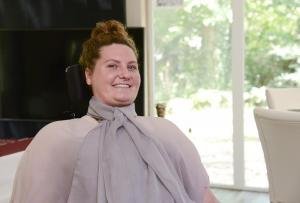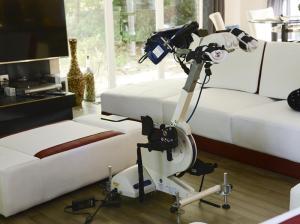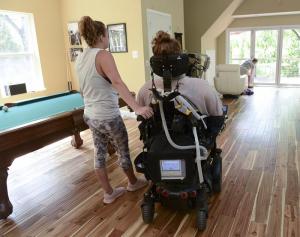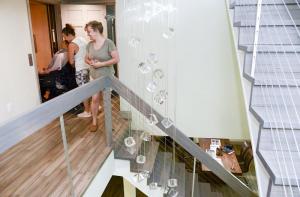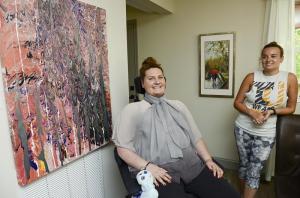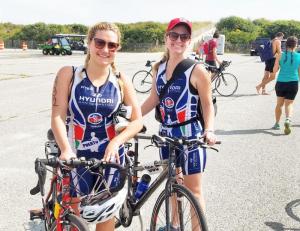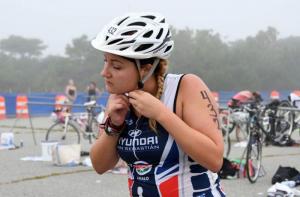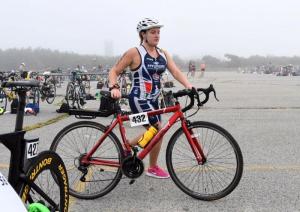From a fourth-floor balcony she designed to overlook her tree-lined neighborhood outside Washington, D.C., Livi Pejo can see the shady streets she used to walk before the crash that left her a quadriplegic.
Two Septembers ago, Livi, then 26, traveled to Dewey Beach with friends to compete in her first triathlon. She finished the race in an hour and 45 minutes - 10th in her age group. “It was a huge accomplishment,” she said, a smile brightening her eyes. “I did a lot better than I expected.”
Livi’s voice is soft; her words come slow and choppy. A gauzy, grey scarf around her throat covers a trach tube connected to a ventilator that breathes for her lungs. Every so often, a muscle spasm shakes her shoulders. Her mother holds her hand until it passes.
The morning after the triathlon, Livi left her Dewey hotel room to buy a bottle of water for the ride home. While she was waiting to cross the street, a driver coming from behind her at high speed swerved off the road, onto the sidewalk and crashed into her.
She never saw it coming. Later toxicology results showed PCP, cocaine and marijuana in the driver’s bloodstream.
Livi was rushed to Beebe Healthcare with extensive injuries to her brain, neck, spinal cord and internal organs. She was airlifted immediately to Christiana Hospital, where she went in and out of consciousness for weeks. She awoke unable to feel or move any muscles below her chin.
Tests showed she fractured her C1/C2 vertebrae - those at the top of her neck, considered the most severe of all spinal cord injuries. Doctors classified the injury as incomplete, meaning some nerve signals were still communicating below the fracture.
By November, Livi had stabilized enough to be transferred to a rehabilitation center for therapy. Her mother, Rezi Pejo, said while Livi was there, her trach several times became blocked. “They didn’t clean her trach very well, and she couldn’t breathe,” Rezi said. “It was very scary. Three or four times, she was almost done. I don’t know how she came back to life.”
Livi can never be completely alone; someone trained to clean and care for the trach must always be close. “It’s why most people with C1/C2 injuries can’t stay at home,” Rezi said.
Livi doesn’t remember being struck or the first few months afterward.
“My birthday is Dec. 4, and that’s the time I started remembering,” she said. “I had friends come for my birthday, and I only remember bits and pieces of it.”
Botched surgeries complicate recovery
Not long after her birthday, Livi had surgery to have a pacemaker installed. At the time, she was on a feeding tube.
During surgery, Rezi said, the doctor moved the feeding tube and forgot to reconnect it to her stomach. For three days after her surgery, any food or medicine she was given through the tube floated around her body until doctors realized she had an infection.
Livi took heavy antibiotics for three months before doctors realized the infection was mostly gone, but had stuck to the pacemaker wires. The infected wires were removed, and she was prescribed a three-month regimen of antibiotics so strong they required government permission. “I lost another month of memory,” she said.
The pacemaker also had to be removed. The doctor said her body would not accept another pacemaker because of the two infections.
“We had planned to have her home for Christmas, but with the infection she went back to worse than she was before,” Rezi said. “She suffered. She lost her hair. She lost her hearing from the strong antibiotic. She didn’t come home until April.”
But her medical problems were still not over. During a surgery to insert a PICC line, used to deliver medications or nutrition or draw blood through an IV, Rezi said doctors cut an artery, causing her to lose so much blood she nearly died. Another surgery was required to repair the damage.
“She’s getting better and better now,” Rezi smiled, plucking and smoothing her daughter’s sleeve. “She spent almost one year suffering from infection. She couldn’t even work on injuries caused by the accident because of the life-threatening infection.”
Rezi is as tough as her daughter, fueled by the anger of a mother whose child has been wronged. “This was not her fault. The only injury she had other than the C1/C2 were scratches on her toe, and now she has holes in her body. We became scared to go to the doctors. Maybe they will do something wrong again.”
Rebuilding a life
When Livi finally returned home, she found she could maneuver only from her parents’ bedroom to the living room in her wheelchair. “I couldn’t even get in my own bedroom,” she said.
So, Livi’s parents - father Ben is an architect and Rezi a plumbing engineer - bought a house down the street to remodel. Livi, herself an award-winning interior designer, helped plan renovations and create two new floors.
“The previous house had all small rooms and was closed up, so I took away the walls and opened up the whole place,” Livi said. “I couldn’t get into the kitchen, and now I’m able to be here while they cook.”
Livi found an eye-gaze computer program compatible with design software she used at work. She uses her eyes to type on a pop-up keyboard and click on-screen commands. Her eyes are weak in the morning, so she works afternoons when it’s easier to focus.
“It detects where my pupil is, and my pupil becomes the cursor and mouse,” she said. “I still want to work. I want to practice and get faster. It just takes so much longer, but it’s doable.”
Rezi was amazed by Livi’s designs. The main living space is now open, modern and decorated in grey and white tones. Sunlight streams through windows, doors and three-foot-wide hallways. An elevator takes Livi from floor to floor; the top floor has an outside patio and will soon house physical therapy equipment and a movie theater.
“I thought she couldn’t do it, and when she started to draw, I was like, wow!” Rezi said. “She wants to start working again and asked her boss to give her some exercises. They are thinking of having her back to work on small projects!”
Livi’s new bedroom is connected by a short, wide hallway to her parents’ bedroom. There is no door between rooms. “She can be independent, but we’re right there if she needs us,” Rezi said.
Livi smiled as she described her new, rotating mattress that moves her sleeping body to prevent bed sores. “Every time it rotates, my hands fly up in the air.”
Before the mattress, her parents had to wake up every two hours to move wedges around Livi’s body while she slept.
Battle over insurance
Paying for Livi’s equipment and healthcare is another struggle. “We have to fight with insurance over every bill,” Rezi said. “They didn’t even want to pay for her catheter.”
Livi receives Social Security disability benefits, but she doesn’t qualify for Medicaid because of her income. While she was working, she purchased insurance in case she was ever in an accident. At the time, Rezi thought itwasn’t necessary. “She was young, she was healthy! What did she need that for?” Rezi asked. “But it was only $10 to do. And now, they are paying a lot.”
Even with insurance, most of Livi’s medical needs and treatments are not covered. Insurance will pay for only 60 hours of physical therapy a year and 40 to 60 hours of nursing care a year. “We have to pay the extra,” Rezi said. “I don’t work because I don’t have anyone to help here.”
Insurance would pay for a $500 manual wheelchair; Livi’s motorized wheelchair cost $8,000. A steam exercise bike Livi rides for two hours a day to move her arms and legs cost the family $24,000.
The driver who hit her was unemployed and uninsured. Livi received $15,000 from the state in compensation. “She can’t work now,” Rezi said. “She wants to work, but in her condition she’s not able to, and there is no help from the government.”
Rezi said people with an injury as severe as Livi’s usually live in a facility, not at home. “There is no law or anything to follow for someone who stays at home,” Rezi said. “It’s a fight every day, and it changed our entire lives. There are rules and laws for the elderly. The young need laws, too.”
Rezi said she is too busy caring for Livi to consider any lawsuits. “We have no time for a lawyer,” she said. Livi’s friend Carmen Izurieta set up a GoFundMe called LiveLoveLivi to help pay for her medical expenses.
Livi faces every obstacle with the same determination and calm as when she faced each leg of the triathlon. “My body has been through a lot because of my level of injury,” she said. “They [doctors] don’t have much hope. It’s been me and my family trying to move forward.”
Rezi agreed. “Most people with C1/C2, they just give meds,” she said. “I want PT or something to actually help her and not just make her sleepy and weak. They don’t do much. They think she’s done from this life.”
Livi joined a Facebook group for people recovering from spinal cord injuries and learned about an emerging new therapy that could help her move again.
Stem cells are a promising treatment for spinal cord injuries because they can stimulate growth from existing cells and replace injured cells. Rezi called a treatment center in Florida that referred her to a New Jersey physician with experience treating C1/C2 injuries with stem cell injections.
“He’s the only doctor that did something,” Rezi said. “A lot of doctors are not doing stem cell for spinal cord injuries yet. There are still so many clinical trials and a lot of research going on. It’s not perfected.”
About a month ago, Livi received her first injections, one into her spine and one into a vein in her arm. “It is supposed to replace damaged nerves so signals from my brain pass easier through injured points,” Livi said. “I must wait six months between injections to make sure my body accepts it.”
If it works, the therapy will start at the C1/C2 and move down her spine. Rezi said they were a little scared because it’s not FDA-approved. “We didn’t want her to suffer, but she decided to do it,” Rezi said. “The doctor said after four to six weeks we might see a change, but after two weeks she started feeling her shoulders. It’s a good sign, but we’ll see what happens.”
Livi said her blood pressure is normal now, and her spasms are different - they’re stronger. “If my lungs could start working again, it would be huge,” she said. “I could get off the vent.” The doctor said six weeks after the injection, Livi may be able to shrug or breathe better.
“So we are counting the weeks,” Rezi said. “We see she has changed, and we are glad to see something happening.”
Before the accident, Livi used to paint. When she found out about fluid art, she had to give it a try, and enlisted help from sisters Ori and Emmi. “Whenever it’s nice outside, we do it,” she said. “I choose the color and sequence of colors, and tell them how much to pour into a cup and they dump on top of the canvas. It makes abstract patterns, and I never know what one will look like.”
Livi has sold a couple paintings on her Etsy page, LOEcreationsArt. Others hang prominently in her new home. “She tries to fill the time,” Rezi said. “Fill the day.”
The driver
For at least 11 days after the crash, the driver who hit Pejo, John Tai Johnson, of Wilmington, was held at Dover Behavioral Health, where he was interviewed by Dewey police.
Dewey Police Sgt. Cliff Dempsey said police charged Johnson with DUI, first-degree vehicular assault and criminal mischief. When Johnson did not appear for a March 6, 2018, scheduled arraignment, a capias was issued for his arrest.
Spokesperson for the Pennsylvania Department of Corrections Nichole Hogan said Johnson is currently serving time for robbery at the State Correctional Institution in Dallas, Pa. He could be released as early as Dec. 8, 2019, or as late as Dec. 8, 2022.
Dempsey said Johnson will be extradited to Delaware when released from Dallas SCI to face charges in the crash that injured Pejo.














